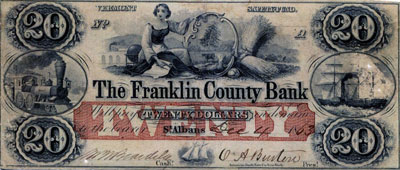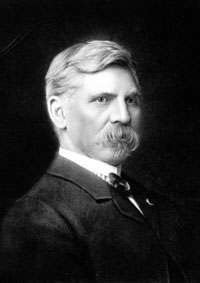Shortly after The St. Albans Raid the jailed Confederates appeared in Montreal Police Court on Nov. 2 where a battery of respected lawyers were ready to do battle over extradition of the robbers.
All 14 men were called to the stand to testify. All were recognized by witnesses from St. Albans. Then, a month-long recess was granted for trial preparation.
It was during this recess that Young wrote to the editor of the St. Albans Messenger commenting sarcastically on news coverage and editorials related to the case. In one of those missives he included a $3 St. Albans Bank note in payment for a newspaper subscription.
A hearing was held on Dec. 13 during which Judge Charles J. Coursol said his court lacked jurisdiction. The men were ordered freed. To add insult to injury, the nearly $87,000 confiscated from the raiders during their arrests was transferred to a Canadian banker whose sympathies were said to be with the Confederates.
There were charges from the U.S. and St. Albans that bribes had been paid. After an investigation the judge and chief of police, who had released the raiders (and then been lax in making arrests after second warrants were issued), were cleared of wrongdoing.
Just five men – Young, Spurr, Swagar, Huntley and Squire Tevis remained in custody to face charges under an 1842 treaty between Canada and the U.S. permitting extradition of criminals who had fled across the border.
The high profile trial began Dec. 27. In January 1865 couriers were ordered to make a wartime trip to Richmond, Va. to bring back the defendants’ military service papers. Secretary of War Edwin Stanton refused a request that President Lincoln authorize a pass to make the journey a less dangerous one.
The raiders that hadn’t been caught remained in hiding in Canada. It was reported that Collins, Doty, Bruce and Moore were smuggled out of Montreal by sled on the frozen St. Lawrence River in early February. Some accounts say they fled to Halifax in the spring and either caught a ship bound for the South or for Europe. Other raiders were said to have married in the interim and to have escaped in a similar way.
The case against the five held in Montreal ended on March 9, 1865 with the court determining it, too, had no jurisdiction. In essence, the judge found that the defendants had acted as combatants of war.
It wasn’t until April 1865 that Canada reimbursed banks in St. Albans for the funds returned to the raiders. The settlement, paid in gold and bank notes returned to the St. Albans Bank, was a controversial one. The exchange rate was no longer as favorable to the U.S. as it once had been. Canada needed just $42,000 from its treasury to pay the 88,000 American dollars.
A decade later, the First National Bank, since it was seen as an agent of the U.S. government, received a reimbursement from the U.S. Treasury of $28,600.
The rebels had been released by Canadian officials in early April 1865, but Young was again charged, this time for an alleged violation of British neutrality laws. He was eager to clear his name, but the Civil War was now over and that charge was dismissed in November 1865.
It was never known what happened to the missing funds taken in the robberies of the St. Albans banks.
There were strong, but unsubstantiated, suspicions that Higbee, who was entrusted by the other raiders to keep charge of $75,000 of the loot, kept it for himself. Having been shot “through and through” from shoulder-to-shoulder during the raid he, too, hid out in Canada and later opened a bank in Texas.
The fact that planning for the St. Albans Raid had taken place in Canada became an embarrassment to the British government during and after the raiders’ trials.
The Canadian Parliament eventually passed laws that, had been they enacted before the Civil War, would have banned all Confederate officials and soldiers from the country.
Unlike today, not all of the holdings of the banks in St. Albans in 1864 were insured by the federal government. Even though the banks’ losses eventually were minimized by payments from Canada, the U.S. government, and international monetary factors, they would prove deadly for two of the three, and were said to have played a lesser role in the demise of the third.
The St. Albans Bank, chartered in 1853, never regained its strength and went out of business in 1866. The First National Bank (just 8 months old at the time of the raid) closed in 1882 or 1883. The Franklin County Bank was closed immediately after the raid by Oscar A. Burton, its president. It went into liquidation “paying all its honest debts,” but “refusing to redeem its bills where a satisfactory account of proper possession could not be proven.”
Visit With A Raider
The St. Albans Raid received considerable international coverage during its day. Since then, there have been for noteworthy anniversary celebrations and a remarkable meeting of local residents in Montreal with Young in 1911.
Veteran’s organizations had opposed a meeting in St. Albans, but when learning of Young’s presence in Montreal, the city immediately sent a delegation to greet him. Among them was U.S. Rep. Frank L. Greene, a former Messenger editor; John Branch, who remembered the raid and published a book containing all of the Messenger’s reporting on the event; and Fuller C. Smith.
“I am quite determined to come back again 50 years hence to see if the rebel sentiment is as strong as it was 50 years ago, and as it is today,” Young was quoted as saying.
Branch reported that Young had called the raid “the reckless escapade of flaming youth.” Young, he added, also “wondered that he ever undertook it.”
Young, educated in Ireland and Scotland at the end of the war, went on to become a railroad owner, bridge builder, author, highly popular lecturer, collector of Native American artifacts, and founding member of the Filson Club Historical Society in his home city of Louisville, Ky. It was said that he rarely spoke about the St. Albans Raid. He died as a respected citizen of Louisville in 1919 and was buried with the epitaph: “I have kept the faith.”
In 1964, Young’s daughter, Elisa, was in St. Albans for the ceremonial unveiling of a commemorative plaque located in Taylor Park. It remains today, situated near the center of the momentous events of that day in October 1864, and still names the St. Albans Raid as the northernmost action of the American Civil War.
Revered History in St. Albans
It’s been nearly 150 years now, but human emotions haven’t changed. So, it is not difficult to fathom the terror that was visited on St. Albans, Vt. on the afternoon of Oct. 19, 1864.
As schoolchildren watched from a third floor auditorium of the Franklin County Grammar School and terrified villagers fought tattering nerves under gunpoint on the central green, 18, or perhaps more Confederate soldiers stole horses, robbed banks, fired pistols indiscriminately – hitting three people and fatally wounding one of them.
If not for the failure of their incendiary devices, a combustible mixture called Greek Fire, the town easily would have been burned to cinders.
The fear of a second assault was to linger for days after the rebels fled to Canada. Even though some of the rebels were captured, the wheels of international law never fully made St. Albans whole. All of the banks had failed within just a few years of their robberies.
Many living in St. Albans in the 1860s already were afraid for their boys and men serving on the frontlines at such ongoing battles as Cedar Creek and other past but equally monumental and bloody fights elsewhere. Vermont, after all, gave more of its sons to the fight per capita than any state in the threatened union.
What has become known here simply as “The Raid,” however, caused the War Between the States to smash out from the newspaper headlines of the hometown St. Albans Messenger and newspapers across the country.
The St. Albans Raid may be a footnote in the great saga of a greater conflict, but it is history that’s still revered in St. Albans.
In 2014, the community will officially mark the 150th anniversary of the St. Albans Raid with a three-day event including a Civil War Costume Ball and dramatic re-enactments of the raid staged on the downtown park. Work has already begun on the dramatization and on the enormous sets and backdrops required to bring that fateful day to life. Descendants of the key players in the raid will attend this event and others.
Learn more about the St. Albans Raid 150th Anniversary Commemoration.





